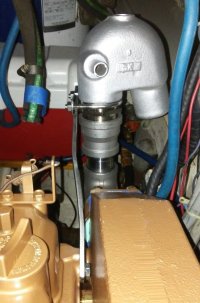CTOlsen
Member III
I've noticed my raw water discharge overboard flow rate has decreased over the last ~3 seasons. After the engine has heated up, the overboard flow is hot enough to show vapor (not just water) coming from the overboard line. Running temps are good, < 180 deg. I've inspected the suction screen, strainer, and the heat exchanger and don't see fouling. I replaced the impeller this spring and it had no effect.
I plan to disconnect the raw water hoses and have a look see inside, I have a small borescope I can use as well. Has any one seen this before? What are your thoughts on where the problem lies?
I plan to disconnect the raw water hoses and have a look see inside, I have a small borescope I can use as well. Has any one seen this before? What are your thoughts on where the problem lies?




